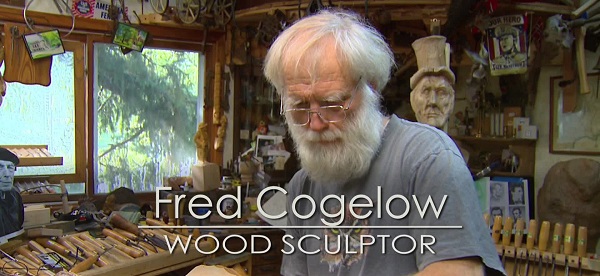
| In the space of his 40 year career, self-taught woodcarver FRED COGELOW has gained an impressive international following. In 2010 American Woodworker magazine profiled him as one of the country’s “Great woodworkers” and “Woodcarving Illustrated” named him 2013 “Woodcarver of the Year.” His many honors include 17 Best of Show Awards at the International Woodcarvers Congress in Davenport, IA. The majority of his carvings are in butternut, with basswood employed as a distant second choice and black walnut an even more distant third. Butternut has long been his preference because of its warmth, availability, relative ease of use, and stability. Over 99% of the wood used in the course of his career is timber that he harvested and dried himself. Fred exhibits a fondness, reverence, and penchant for woodworking tools, especially traditional hand tools. At the center of the “operating theatre” in his studio is a stalwart carving easel, created from the cast iron base of an old mortician’s workbench. (A tool collector friend sold it to him for $25 in the late ’70’s saying, “You should really be the one to have this,” — a most considerate gesture!) The carving bench is surrounded by tool cabinets containing hundreds of gouges, skews and other edge tools, all within easy reach. His studio, along with an office and final-drying room for his timbers, occupies the second floor of a re-purposed, reconstituted and again remodeled farm outbuilding which came courtesy of his mother-in-law-to-be. It stands 20 feet from the back door of his home, originally built by his great-grandfather in 1900. Above his carving bench is the “contribution to technological advancement” in which he claims to take his greatest pride, his “Norwegian track-lighting system” (...an upwards glance reveals an old hay mow trolley on a wooden track from which is suspended a basket holding a single large candle). The room is packed with objects that Fred uses for inspiration and models. Along with antlers and sundry skulls are numerous bits of saddlery and harness, a variety of musical instruments and horns in various states of distress, bits of weathervanes and windmill weights, more tools and a plethora of curios. Two lofts are enclosed by sections of old curved altar railings, complemented nicely by a stained glass window rescued from a demolished church. Amidst all of this hangs a sign with a quote from Thomas Edison that reads “To invent you need a good imagination and a pile of junk.” Fred describes carving as both an artistic and logical endeavor, but he’s been carving for so long and works so intuitively that he finds it difficult to put the creative process into words. “Much of it is the practice of learning to see, —to see what you actually wish to do, and to see what you’ve actually done to that point, rather than believing what your brain tells you you’re seeing.” he explains. He then adds that, given the tools, materials, specific end results and a coherent way of getting there, “a lot of it boils down to simple engineering.” Fred’s work is notable in several genres of carving, but it is most exceptional and original in mezzo- (“middle-” ) relief portraiture. Mezzo-reliefs are essentially linear compositions enhanced through full orchestration—the full and repeated manipulation and exploitation— of the available depth. Most crucial is the strategic undercutting which completes the process, greatly enhancing the illusion of depth. It is a practice with few absolute rights and a great many wrongs. |
